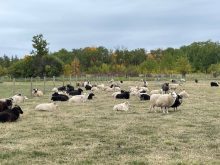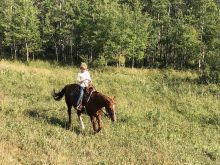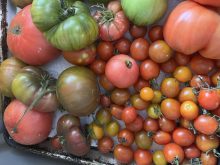Garden crops from beans to apples have been a passion of mine from my childhood in Wales. On our small 17-acre Welsh farm in southwest Wales, we grew or raised most of the vegetable food that we ate from potatoes to apples as well as milk, eggs, pork and chickens. The mild climate allowed us to leave most vegetables in situ such as carrots, beets, leeks and turnips over the winter in the garden to harvest when needed. The harvesting of broccoli was in March, and fava beans and peas in May, to runner beans, turnips and fruit in the fall. Refrigeration and freezing were not needed or available.
Read Also

Claas brings 1000 Series SP forage harvesters to Canada
In mid-August, Claas unveiled its new line of Jaguar forage harvesters at an event in Visalia, California, deep in the heart of that state’s dairy region.
In my graduate years in central Florida, surprisingly there was only a short window for growing most vegetables and fruit from February after the winter frosts until early June when it became much too hot even for tomatoes to survive outdoors.
As far as Prairie gardening is concerned, we have essentially from April for frost-tolerant crops and mid- to late May for tender vegetables followed by four to five full months of long, sunny days hopefully in most years with adequate rainfall and perhaps access to irrigation in dry summers. We, in fact, due to our northern location and very long summer days, have some of the world’s best vegetable- and fruit-growing conditions.
During the early 1970s in Ontario as a diagnostic plant pathologist, I learned a lot about vegetable and fruit crop production as well as working with the provincial field crop industry. I was a frequent visitor to “Bradford Marsh,” Ontario’s intensive muck soil vegetable production cropland where micronutrients were every bit as important as macronutrients for optimal vegetable crop production.
In my five-acre garden just west of Edmonton, I grow a very broad range of fruits and vegetables. I have done a lot of plant breeding and selection over the years, and I am sure that many, if not most, of you have heard of the very popular Evans cherry, perhaps 10 million or more of these cherry trees are now grown across Canada and the northern United States. If you check the seed catalogues you will even find Evans Extra Early Tomatoes.
Vegetable-wise, I grow runner beans, peas, fava beans, potatoes, leeks, onions, asparagus, cucumbers, zucchini, squash, carrots, parsnips, corn, garlic, tomatoes, tomatillos, all of the cabbage family as well as herbs and some exotics.
In the fruit department, aside from cherries, I grow apples, apricots, pears, plums, grapes, melons, cantaloups, raspberries, blackberries, rhubarb, strawberries and lots of figs. I supply apple, pear and plum fruit budwood for propagation periodically to commercial nurseries from Ontario to British Columbia.
In my 20 or so years of active association with Robert Saik, formerly the president of Agritrend Agrology, I often gave talks on vegetable and fruit growing to Hutterite colonies in both Canada and the United States. There were very many times when I helped solve fruit and vegetable production problems at Hutterite gardens, particularly in Manitoba. I helped the colonies with tomatoes, onion, potato and asparagus on the vegetable side and, fruit-wise, with apple, raspberry, strawberry, rhubarb and cherry production.
The Hutterite colonies in Manitoba, Saskatchewan, Alberta, North Dakota and Montana have a significant effect in their Prairie jurisdictions, particularly on vegetable production for the general populace via farm market gardens.
To put the Hutterite contribution into perspective, there are around 370 colonies in Canada and 140 in the United States. Each colony is around 100 individuals, making a total of more than 50,000 personnel. On the Canadian Prairies, there are 175 colonies in Alberta, 110 in Manitoba and 70 or so in Saskatchewan. Most of the U.S. colonies are located in either Montana or North Dakota. Each colony farms around 10,000 acres, with a range of three to 20,000 acres, making the Canadian total of cropland holdings by the colonies around 3.75 million acres.
Alberta has 52 million acres, of which 25 million is arable and 27 million acres are grazing lands or permanent pastures. Saskatchewan has 37 million arable acres greater than both Alberta and Manitoba combined. It also has 30-plus acres of pasture lands. Manitoba comes in third with 11.5 million acres of cropland and hay crops with considerable acres of permanent pasture and grazing land. In total, the Canadian Prairies have 74 million acres of cultivated cropland out of a national total of 94 million acres in Canada. A final statistic before I deal with specific topics on vegetable and fruit crops growing on Prairie farms is that in Canada only five per cent of our country’s total acreage is actually farmland.

In my next four columns, I will deal with farm and colony vegetable and fruit production along with the problems of production and, to my knowledge, solutions to known problems.
Farmers and Hutterite colonies have distinct advantages over vegetable- and fruit-growing small holdings and market gardens in their ability to move to new cropland for crop rotations. All have, when necessary, the right to use pest-appropriate control products for weed, diseases and insect problems.
Move garden to new growing area
A vegetable and fruit crop-growing problem that I was able to look at on both farms and colonies was the fact that despite having hundreds or thousands of acres of cropland, the “garden” had been in the same location for 20 to 40 years or even more. In several instances for both colonies and individual farms, I recommended it would be most beneficial if the garden, or gardens, were moved to a new growing area. Oftentimes, in the “old” growing area, the garden had become saline from using groundwater with a high mineral content combined with repeated livestock manures that had high salt levels. Besides, there were also more than a few soil-borne diseases at these old sites that could damage virtually every crop that was grown on the “old” garden.
I will begin the series with vegetable production and end with effective fruit-growing strategies, which can bring income and pleasure to our long and hot Prairie summers.
In all horticultural enterprises the quote “He or she who fails to plan, plans to fail,” could apply.
Seven Prairie farm vegetable crops I will cover will be a broad range of vegetables grouped according to family, for instance, vegetable crop plants that are closely related to each other.
- The cabbage family — cabbage, cauliflower, broccoli, turnips, rutabaga, kale, sprouts and kohlrabi
- The potato family — potatoes, tomatoes, peppers, eggplant and tomatillos
- The cucumber family — cucumbers, squash, melon, pumpkin and zucchini
- The carrot family — carrots, parsnips and dill
- The beet family — beets, Swiss chard and spinach
- The bean family — dry beans, pole beans, runner beans, peas, lentils, fava beans and soybeans (edamame)
- The onion family — onions, shallots, chives, green onions, leeks and garlic
Rhubarb will be treated as fruit and, of course, tomatoes, peppers and melons as vegetables despite being fruit.
I came across this thought recently, “Knowledge is knowing that a tomato is a fruit. Intelligence is not putting it in a fruit salad.”
There will be some vegetable or fruit crops I may not deal with in detail, but I will certainly mention them in context.
















